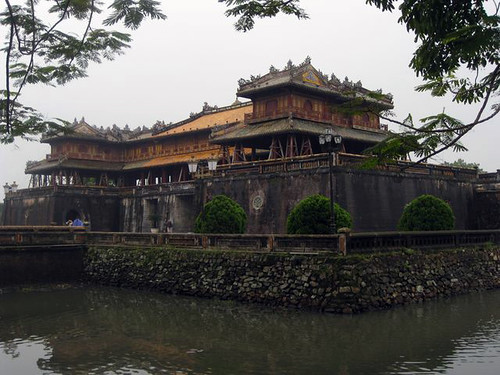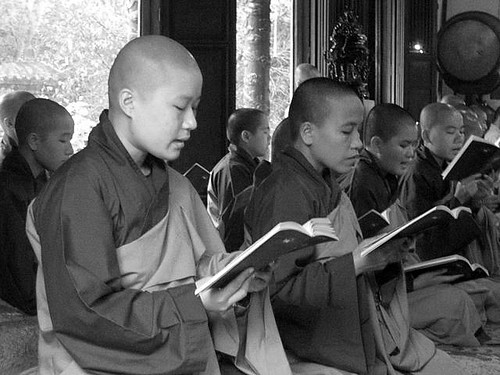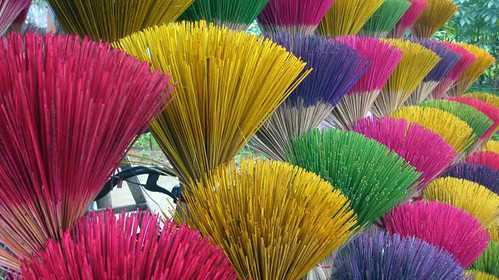Destination: Hue (pronounced "way"), Vietnam
Number of Days there: 2
One thing unexpected: Most of the restaurant walls are decorated like a truck stop bathroom - graffiti filled from all the travelers over the years
Times we took the: Boat: 0; Bus/Minivan: 0; Train/Subway: 1 Taxi/Car: 2; Motorbike: 0
Where we stayed: Binh Duong I ($8 US) - small room, but with WIFI, satellite TV and hot water, you can't beat the value
Favorite Restaurant: Good and cheap breakfast at Cafe On Thu (pronounced "two") Wheels
Best of: We happened upon a monastery with chanting monks!
Worst of: A rich cultural history virtually forgotten and abandoned over time
Hue seems to be forgotten in the pages of history. It was recently declared an UNESCO World Heritage Site and rightly so, the town is rich in history but at this point in time most of the sights are run down and in need of restoration. There are signs however that Hue will be an amazing place once the money and time are put into it. The Citadel in the middle of town was virtually destroyed during the American/Vietnam War and the area around Hue was where some of the fiercest battles in the war including the infamous Hamburger Hill took place. Even on this day, the area is still riddled with UXO (Unexploded Ordinance) and unable to be visited from all the heavy bombing.
We decided that we would spend our first day in Hue wandering around the old part of town and the Citadel. The Citadel was home to the emperors of the Nguyen Dynasty and Hue itself was the capital of Vietnam from 1802 until 1945 when the communist movement (led by Ho Chi Minh of course) swept through the country and forced the royal family out of power and into exile. After realizing that the Citadel was closed for lunch, we opted to take a cyclo (a bicycle with a small carriage attached to the front - 70,000 per hour) around the neighborhood and get a little tour of the town. The cyclo's driver's name was Mr. Hue and he spoke English very well. We checked out a couple of Chinese temples, the market, and a few other sights of interest. He also found someone to let us into their house (which used to be a member of the royal families abode) which was very interesting with the mother of pearl inlaid woodwork and intricate carving adorning all the pillars and furniture. At the end of the tour we waved goodbye to the cyclo driver as he dropped us at the entrance of the Citadel (entrance fee 60,000 dong). Upon entering the site we quickly realized just how run down the place was. The walls around the citadel were the most impressive part, still standing after the test of war and time. There was evidence of UNESCO trying to work their magic, several of the buildings were being worked on and repaired. Other than that, the rest of the complex was rather fake and included plastic guardian lions that had been spray painted gold. Let's just say they have a long way to go before this resembles its glory days.
The next day it was raining, again, as came to be a consistent theme for all our time in central Vietnam. Instead of taking the motorbike tour that we had signed up for, we hopped in Thu's brother's brand new Toyota SUV with another couple from Wyoming (small world eh?). While the motorbikes would have been better in nicer weather, we can't say we were disappointed in our change of transportation given the weather. Thien Mu Pagoda was our first stop. An impressive octagonal temple built in the 1600's was home to the famous monk Thich Quang Duc who drove to Siagon and set himself on fire to protest against President Ngo Dinh Diem's (The dictator like President of South Vietnam at the time. Not only did he disregard the election process, but also oppressed all religions other than Catholicism, his religion. He was killed by his own troops shortly after the monk burning and just before the North invaded the South.) oppression of Buddhism. Aside from the temple itself; his car, a picture of the momentous occasion (flames and all), as well as a weird picture of his heart (the only part of the monk that was not consumed by the flames) are on display. Next stop on the docket was another temple, only this one was set in the woods and the monks were chanting, i.e. singing. One of the elder monks was leading the chants with a microphone and speaker. The other monks were seated around him also chanting dressed in varying colored robes. It was certainly a memorable experience and we just watched them sing in unison for about twenty minutes before moving on. After the temple hopping we hit one of the more well taken care of sights in the area - the Tomb of Tu Duc. Of all the emperors of the Nguyen Dynasty, Tu Duc has the largest and most preserved tomb. The grounds are massive and it's amazing to think that all the lands and buildings dedicated to one man's final resting place. We made one last stop at the Thanh Toan Bridge (Japanese Bridge). Built in the 1600's, the bridge has survived numerous storms and floods and still stands is it did when it was built.
We finished the morning back at Thu's for a little lunch before catching the bus. Getting our fill of some cultural history, we were on our "Hue" to our next stop, Hoi Ann.







No comments:
Post a Comment